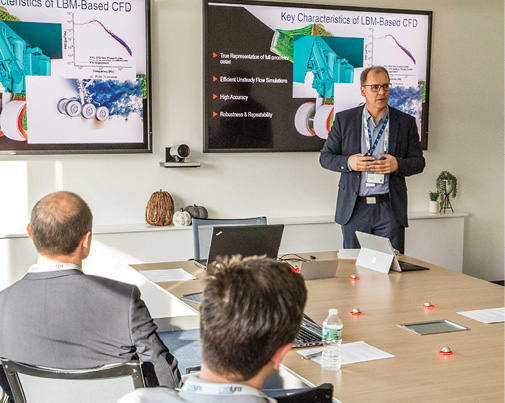
Aerodynamic performance testing is but one of the many functions available to designers using SIMULIA or comparable 3D simulation software. Image courtesy of Dassault Systèmes.
Striving for Zero
Reducing, or even eliminating, the use of physical prototypes can yield tremendous benefits. The question is: How do you proceed?
Latest News
February 1, 2019
Product design and engineering is an inexact science. From estimates about material strength to assumptions about how the finished good will feel in the consumer’s hands, this all-important part of the manufacturing process is often an educated guessing game, one that can be quite costly to its players.
The solution has long been to machine, fabricate or 3D print a physical replica of the product, and then use it to validate design suppositions, perform physical testing or simply watch how everyone on the team reacts to your latest brainchild. If it doesn’t look right or elicit the expected response, it’s back to the proverbial drawing board, followed by multiple prototypes until the optimal design is achieved.
Playing with Clay
The problem with this method is clear: prototyping is expensive, and it takes time. Lots of time. Automakers, for instance, spend millions each year sculpting clay models for aerodynamic testing, and many months analyzing how they fare under various conditions.

“The models themselves are expensive, but the equipment needed to test product designs is even more so,” says Ales Alajbegovic, vice president of the worldwide Centers of Excellence and Services at Dassault Systèmes. “An OEM (original equipment manufacturer) can easily spend upwards of $200 million to construct a wind tunnel, a huge investment that could easily be avoided through the use of digital modeling and simulation software.”
Over the past decade or so, digital simulation tools have become increasingly able to mimic reality. What’s more, they can show us things that aren’t discovered via traditional prototype and testing methods. Internal material stresses, unpredictable electrical flow, poor aerodynamics—these are just a few of the secrets that often remain untold until it’s too late to cost-effectively do anything about them. So why aren’t more people using these software tools?
According to Alajbegovic, the manufacturing industry is addicted to physical prototypes. “Much of the reluctance is simply habit,” he says. “For automobiles, at least, physical prototypes have been used for the last hundred years, and it’s difficult to change that mindset. And then there are regulatory requirements, safety considerations and so on. I’m not saying it’s impossible to move to a digital prototyping platform—a number of companies have proven that it’s not—but it’s definitely an uphill battle in some cases.”
Fighting the Good Fight
For those willing to climb the hill, however, drastic efficiency improvements are there for the taking, namely the production of better products in less time and for a lower cost. One example is Jaguar Land Rover—after nearly closing its doors forever, the British automaker restructured its product development process with a new emphasis on digital prototyping.
The result? Over the past 10 years, the company has “significantly increased its revenue as well as its production output,” Alajbegovic says. “They’re also much more flexible, because once you have a digital process established, you’re able to test so many more ideas than when you’re doing that physically.”
Even if you want to use digital prototyping, the question becomes: how does your department implement it? Buying or subscribing to a moderately expensive suite of modeling and simulation software is one thing; actually fitting it into your engineering processes is another. It does require some effort to change existing processes, but there’s no need to start from scratch, says Dale Berry, senior director for SIMULIA technical product experience at Dassault Systèmes.
“The beauty of a modern digital engineering platform is the availability of tools that allow users to focus on the desired end result, be it reducing drag on commercial aircraft or improving crash performance in electric vehicles,” he says. “In these and other applications, we have leveraged our extensive industrial experience to develop, document and validate various manufacturing processes, greatly reducing the amount of time needed to weave digital tools into traditional engineering activities. But whether they use our platform or not, I strongly believe that the companies that follow down the digital path will be the leaders of tomorrow.”
Feeding the Loop
But wait; not so fast. Jessica Menold, assistant professor of engineering design and mechanical engineering at Penn State University, says physical prototypes aren’t necessarily bad, just misused.
“It’s not that you’re wasting time or money on physical prototypes, because you can be just as wasteful building digital ones,” Menold says. “The problem comes when you’re building a prototype—physical or digital—that doesn’t match up with the question you need to answer. Ultimately, that’s what a prototype should do: validate a specific assumption, so you can learn from it. You need to close the feedback loop.”

In addition to her teaching responsibilities, Menold co-manages the THRED (Technology Human Research and Engineering Design) Group, a research lab that focuses on several key aspects of the design process, including when and how to prototype. She says her work will hopefully help the industry understand how engineers and designers approach this important step—the types of prototypes and design artifacts they’re creating, and whether there’s a way to better predict the trajectory or outcomes of those efforts.
The Freedom to Fail
To Menold, the ideal prototyping scenario is one that generates smaller scale physical prototypes more frequently, together with some level of digital modeling and simulation. “The physical world doesn’t always behave the same as the digital one, so I think you do need to switch between the two in order to gain a more complete picture,” she says.
“It’s not that you’re wasting time or money on physical prototypes, because you can be just as wasteful building digital ones.”
Digital tools typically fit best when time and resources are limited, Menold adds, since they make it fairly easy to perform multiple iterations quickly, but that doesn’t mean designers shouldn’t keep their eyes on the basic requirement for any prototyping effort: What question will it answer? “Prototyping is about testing to failure,” she says. “If you haven’t done that, then you haven’t really learned the constraints of your design.”
Successful prototyping—however it’s done—comes down to making better decisions up front: decisions based on the available resources, the time needed to build a prototype, the relative cost of each method and what the designer is actually trying to test, Menold explains.
“At our lab, physical, full-scale prototypes are often not feasible,” says Menold. “In these instances, we typically simulate a physical part with a digital twin, and actually have a project going right now where we analyze the evolution of the digital twin as it progresses from initial concept to 3D-printed prototype to finished product.”
Through it all, it’s important to evaluate what kind of prototyping tools and strategies designers should use, which is why Menold and her research team have developed methodologies, or frameworks, that act as starting points.
“[These methods] allow the designers to say, ‘What are we trying to accomplish here? Are we building a prototype to test for technical feasibility, or user desirability, or is this even a viable product design?’” she says. “If you can’t work through these questions, building a prototype is quite possibly a waste of time, no matter which methodology you use.”
Kip Hanson writes about all things manufacturing. You can reach him at [email protected]
Subscribe to our FREE magazine, FREE email newsletters or both!
Latest News






